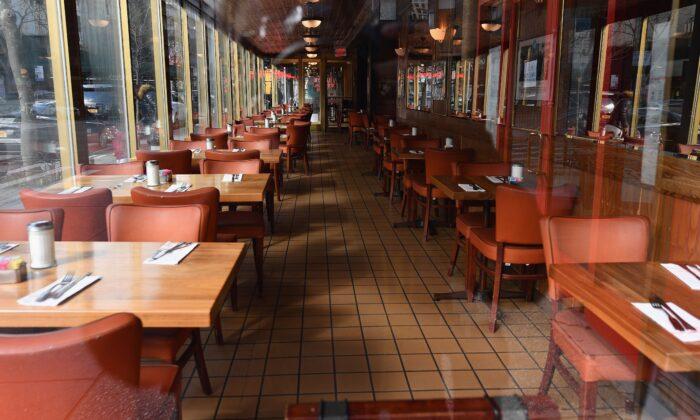Visiting with a restaurant owner last night, he told me that they fared pretty well throughout the pandemic period. They had a large restaurant so the capacity restrictions didn’t hurt their business. They have a known brand and had already set up the takeout and delivery apparatus. They had high ranks in every rating service, so the place became a go-to for people. And they profited.
The same cannot be said about smaller and newer restaurants. Countless numbers of them died in this period. We still don’t have a firm number but some estimates are nearly 100,000.
This was the opposite of market competition. It was a planned destruction of the sort we never thought we would see in the United States.
Thus the implied conclusion: don’t allow indoor dining! Otherwise COVID will spread like wildfire! This was one of many tens of thousands of fake studies produced this year and following.
Let’s take a look back.
The study in question was based on interviews with 314 people who had been tested of their own volition. It included 154 patients with positive test results and 160 control participants with negative test results.
The interviews took place two weeks following the tests, and they concerned life activities two weeks prior to getting the test.
Remember that what alarmed people about COVID was the prospect of dying. The study says nothing about this subject, nor about hospitalization. It’s a fair assumption that the positive cases being interviewed here got COVID (presumably, if the tests are accurate, which they are not) and got over it.
This alone is interesting simply because it reveals how much the whole subject had been changed: the pandemic became a casedemic from early on.
- Wearing a mask or not wearing a mask
- Going to church
- Riding on public transportation
- Attending large house parties
- Going to the gym
- Going to the office
- Going to the hair salon
- Going shopping
The massive power of the state had been deployed all over the United States and the world to force the closure of churches, gyms, offices, salons, and malls. Mask mandates became the new normal. The public was invited by health authorities to jeer at, denounce, and turn in anyone who did not have a cloth strapped to his or her face.
All of this happened in complete contradiction to every commercial right, property right, or normal human freedoms. We threw it all away in the name of virus control. Our lives were completely upended and our assumptions about our rights and liberties have been overturned.
- Salons Won’t Get You Sick, CDC Reports
- You Won’t Catch Covid at the Gym, CDC Shows
- No, Your Hairstylist Doesn’t Spread the Coronavirus
- Scared to Go Shopping? Don’t Be, Says the CDC
- Your Mask Is Pointless, New Study Says
- Churchgoers Shouldn’t Fear Sickness, Scientists Reveal
- Study: Your House Party Didn’t Spread the Virus
The one place that the study revealed a positive correlation between positive cases and life activities was going to restaurants.
- New COVID-19 Study Blames Coronavirus Spread on Restaurant Dining
- Coronavirus Patients Twice As Likely To Have Eaten In Restaurants Before Getting Ill: CDC Study
- Adults with COVID-19 twice as likely to have eaten at restaurants, CDC study finds
- Study finds bad news for bar and restaurant-goers during COVID-19
- US govt study highlights Covid-19 risk from bars and restaurants
And here is what makes this even stranger. The interviewers never asked the people in the survey whether they were eating indoors or outdoors, as incredible as that seems. The authors admit this: “Of note, the question assessing dining at a restaurant did not distinguish between indoor and outdoor options.”
Why not? Did they just forget to ask?
Which is to say that even if the results are meaningful—and there’s so much about this study that is murky and error-prone—they are practically useless for knowing what to do about it. If there is no distinction between indoor and outdoor, all speculation about ventilation or crowds or the presence of food and so on, was utterly pointless. Without knowing that, we were at a loss to figure out any answer to the question of why and what to do. Instead, the message came down to: don’t go out to eat.
Here is how shoddy the science became. In the discussion, the authors wrote the following:
“Direction, ventilation, and intensity of airflow might affect virus transmission, even if social distancing measures and mask use are implemented according to current guidance. Masks cannot be effectively worn while eating and drinking, whereas shopping and numerous other indoor activities do not preclude mask use.”
The study itself supported none of that paragraph.
The survey never asked about ventilation because the people who made the survey somehow forgot to make a query concerning indoor vs. outdoor dining. As for masks, the study did in fact ask respondents about mask wearing and the results showed no correlation between the sickness and whether and to what extent people were wearing masks!
In other words, that paragraph in the discussion is contradicted in two places by the authors’ own study.
In addition, the authors themselves point to an intriguing issue: the people in the survey might have biased their answers based on their personal knowledge of the test results.
Think about it this way. The people who had a positive COVID test are more likely to ask themselves the great question: how did I get this? Going to restaurants is such a rare activity these days that it stands out in one’s mind. When the survey asked people if they had gone out to eat, it is possible that the memory of the COVID-positive person might be more likely to blame the restaurant, whereas the COVID-negative person might be more likely to have forgotten the locale of every meal in the last 30 days.
In other words, the real result of the study might be: COVID patients are more likely to scapegoat restaurants rather than gyms, churches, and salons. Alas, none of these interesting considerations appeared in the media-rendered version of this study: panic and keep the lockdowns in place!
Lockdowns had become a conclusion in a desperate search for evidence. Imagine if you undertook a study of C-positive vs. C-negative cases and asked the people if they mostly wear lace-up or slip-on shoes. If you come up with some positive correlation, the CDC will publish you and a media panic will ensue.
This is precisely where we were for two to three years. The media became the handmaiden of lockdown tyranny—and later masks and forced jabs—blasting out simplistic versions of sketchy studies to keep the panic going as long as possible. And the public, which was back then far too trusting of the media and its capacity for rational and accurate reporting, ate it up.
In light of all of this, and what we are finding out and know for sure on a whole host of issues, it seems highly likely that media science reporting has lost credibility for a generation. It certainly deserves that fate. Meanwhile, smaller restaurants and bars got destroyed while larger ones thrived.
Bad science backing bad policy, amplified by an ignorant media, led to disaster. Never again!





